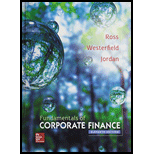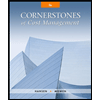
Fundamentals of Corporate Finance with Connect Access Card
11th Edition
ISBN: 9781259418952
Author: Stephen A. Ross Franco Modigliani Professor of Financial Economics Professor, Randolph W Westerfield Robert R. Dockson Deans Chair in Bus. Admin., Bradford D Jordan Professor
Publisher: McGraw-Hill Education
expand_more
expand_more
format_list_bulleted
Concept explainers
Question
Chapter 20, Problem 18QP
Summary Introduction
To determine: The break-even price per unit.
Introduction:
Break-even price is a price at which a firm earns exactly no profit. Break-even quantity sold is calculated by setting the
Expert Solution & Answer
Want to see the full answer?
Check out a sample textbook solution
Students have asked these similar questions
Do not answer wit incorrect values i will unhelpful!
What are the implications of missing a credit card payment in finance?
Omni Advisors, an international pension fund manager, uses the concepts of purchasing power parity (PPP) and the International Fisher Effect (IFE) to forecast spot exchange rates. Omni gathers the financial information as follows: Base price level 100 Current U.S. price level 105 Current South African price level 111 Base rand spot exchange rate $ 0.188 Current rand spot exchange rate $ 0.171 Expected annual U.S. inflation 7% Expected annual South African inflation 5% Expected U.S. one-year interest rate 10% Expected South African one-year interest rate 8% Required:
a. The current ZAR spot rate in USD that would have been forecast by PPP.Note: Do not round intermediate calculations. Round your answer to 4 decimal places.
b. Using the IFE, the expected ZAR spot rate in USD one year from now.Note: Do not round intermediate calculations. Round your answer to 4 decimal places.
c. Using PPP, the expected ZAR spot rate in USD four years from now.Note: Do not round intermediate calculations.…
Chapter 20 Solutions
Fundamentals of Corporate Finance with Connect Access Card
Ch. 20.1 - Prob. 20.1ACQCh. 20.1 - Prob. 20.1BCQCh. 20.2 - What considerations enter into the determination...Ch. 20.2 - Explain what terms of 3/45, net 90 mean. What is...Ch. 20.3 - Prob. 20.3ACQCh. 20.3 - Explain how to estimate the NPV of a credit policy...Ch. 20.4 - What are the carrying costs of granting credit?Ch. 20.4 - What are the opportunity costs of not granting...Ch. 20.4 - Prob. 20.4CCQCh. 20.5 - Prob. 20.5ACQ
Ch. 20.5 - Prob. 20.5BCQCh. 20.6 - Prob. 20.6ACQCh. 20.6 - What is an aging schedule?Ch. 20.7 - What are the different types of inventory?Ch. 20.7 - What are three things to remember when examining...Ch. 20.7 - Prob. 20.7CCQCh. 20.8 - Prob. 20.8ACQCh. 20.8 - Which cost component of the EOQ model does JIT...Ch. 20.A - Prob. 1ACQCh. 20.A - Prob. 1BCQCh. 20.A - Evaluating Credit Policy [LO2] Bismark Co. is in...Ch. 20.A - Credit Policy Evaluation [LO2] The Johnson Company...Ch. 20.A - Prob. 3QPCh. 20.A - Prob. 4QPCh. 20.A - Prob. 5QPCh. 20 - What is the difference between the accounts...Ch. 20 - Prob. 20.2CTFCh. 20 - Prob. 20.7CTFCh. 20 - Prob. 1CRCTCh. 20 - Prob. 2CRCTCh. 20 - Prob. 3CRCTCh. 20 - Five Cs of Credit [LO1] What are the five Cs of...Ch. 20 - Prob. 5CRCTCh. 20 - Prob. 6CRCTCh. 20 - Prob. 7CRCTCh. 20 - Prob. 8CRCTCh. 20 - Prob. 9CRCTCh. 20 - Prob. 10CRCTCh. 20 - Prob. 1QPCh. 20 - Size of Accounts Receivable [LO1] The Red Zeppelin...Ch. 20 - Prob. 3QPCh. 20 - Prob. 4QPCh. 20 - Terms of Sale [LO1] A firm offers terms of 1/10,...Ch. 20 - Prob. 6QPCh. 20 - Prob. 7QPCh. 20 - Prob. 8QPCh. 20 - Evaluating Credit Policy [LO2] Air Spares is a...Ch. 20 - Prob. 10QPCh. 20 - Prob. 11QPCh. 20 - Prob. 12QPCh. 20 - Prob. 13QPCh. 20 - Prob. 14QPCh. 20 - Prob. 15QPCh. 20 - Prob. 16QPCh. 20 - Prob. 17QPCh. 20 - Prob. 18QPCh. 20 - Prob. 19QPCh. 20 - Prob. 20QPCh. 20 - Prob. 21QPCh. 20 - Prob. 22QPCh. 20 - Credit Policy at Howlett Industries Sterling...Ch. 20 - Prob. 2M
Knowledge Booster
Learn more about
Need a deep-dive on the concept behind this application? Look no further. Learn more about this topic, finance and related others by exploring similar questions and additional content below.Similar questions
- Delta Company, a U.S. MNC, is contemplating making a foreign capital expenditure in South Africa. The initial cost of the project is ZAR11,000. The annual cash flows over the five-year economic life of the project in ZAR are estimated to be 3,300, 4,300, 5,290, 6,280, and 7,250. The parent firm's cost of capital in dollars is 9,5 percent. Long-run inflation is forecasted to be 3 percent per annum in the United States and 7 percent in South Africa. The current spot foreign exchange rate is ZAR per USD = 3.75. Required:. Calculating the NPV in ZAR using the ZAR equivalent cost of capital according to the Fisher effect and then converting to USD at the current spot rate. - NPV in USD using fisher effect Converting all cash flows from ZAR to USD at purchasing power parity forecasted exchange rates and then calculating the NPV at the dollar cost of capital. - NPV in USD using PPP rates Are the two USD NPs different or the same? What is the NPV in dollars if the actual pattern of ZAR per…arrow_forwardWhat is the 50/30/20 budgeting rule in finance?arrow_forwardHow do student loans impact long-term financial health?arrow_forward
- With regard to foreign currency translation methods used by foreign MNCs, Multiple Choice a. foreign currency translation methods are generally only used by U.S. based MNCs since foreign firms have a built-in hedge by being foreign. b. are generally the same methods used by U.S.-based firms. c. are exactly the same methods used by U.S.-based firms since GAAP is GAAP. d. none of the options.arrow_forwardCray Research sold a supercomputer to the Max Planck Institute in Germany on credit and invoiced €11.60 million payable in six months. Currently, the six-month forward exchange rate is $1.18 per euro and the foreign exchange adviser for Cray Research predicts that the spot rate is likely to be $113 per euro in six months.Required: a. What is the expected gain/loss from a forward hedge?Note: A Negative value should be indicated with a minus sign. Do not round intermediate calculations. Round your final answer in whole dollars not in millions.arrow_forwardWhat is the time value of money and how is it calculated? need answer!arrow_forward
arrow_back_ios
SEE MORE QUESTIONS
arrow_forward_ios
Recommended textbooks for you
 EBK CONTEMPORARY FINANCIAL MANAGEMENTFinanceISBN:9781337514835Author:MOYERPublisher:CENGAGE LEARNING - CONSIGNMENT
EBK CONTEMPORARY FINANCIAL MANAGEMENTFinanceISBN:9781337514835Author:MOYERPublisher:CENGAGE LEARNING - CONSIGNMENT Cornerstones of Cost Management (Cornerstones Ser...AccountingISBN:9781305970663Author:Don R. Hansen, Maryanne M. MowenPublisher:Cengage Learning
Cornerstones of Cost Management (Cornerstones Ser...AccountingISBN:9781305970663Author:Don R. Hansen, Maryanne M. MowenPublisher:Cengage Learning



EBK CONTEMPORARY FINANCIAL MANAGEMENT
Finance
ISBN:9781337514835
Author:MOYER
Publisher:CENGAGE LEARNING - CONSIGNMENT

Cornerstones of Cost Management (Cornerstones Ser...
Accounting
ISBN:9781305970663
Author:Don R. Hansen, Maryanne M. Mowen
Publisher:Cengage Learning
The management of receivables Introduction - ACCA Financial Management (FM); Author: OpenTuition;https://www.youtube.com/watch?v=tLmePnbC3ZQ;License: Standard YouTube License, CC-BY